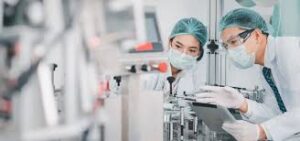
- Blogs
Role of Medical Robots in Advanced Surgery
- October 17, 2024
- By admin
Technology as an enhancer has invigorated the medical world to a large extent, and in this regard, robotics systems are becoming a significant player in advanced surgery. In terms of surgical procedures, medical robots are changing everything: they ensure greater precision, flexibility, and better patient results. Here’s how medical robots are changing the outlook of the future of surgery and what makes them an absolute necessity in contemporary medicine.
1. Superior Precision and Control
High precision is one of the main advantages of medical robots in surgery. The robotic systems allow surgeons to perform complex procedures with greater precision than traditional manual methods. Additionally, the advanced imaging and motion control result in navigation through tight spaces and delicate structures with minimum invasiveness and fewer chances of making mistakes that often occur with human performance.
For example, in robotic-assisted laparoscopic surgeries, very few incisions are made, and a surgeon takes control over some robotic arms that mimic the movement of a surgeon but with more steadiness and accuracy. This enhances the surgical outcomes particularly in procedures that require extremely intricate movements like cardiac or neurological surgery.
2. Minimally Invasive Surgery
Medical robots provide access to MIS surgery, which increases minimal invasiveness in comparison to open surgeries. Some benefits include reduced pain, shorter recovery times, and diminished opportunity for infection. The new standards for MIS now are robotic systems; specifically, the da Vinci Surgical System, which offers very high-definition 3D visualization and extremely precise control over surgical instruments.
These benefits make robotic surgery a recommendable procedure for both patients and the healthcare providers, as it is guaranteed to speed up recovery and bring better all-around results.
3. Increased Flexibility and Dexterity
The old tools limited the surgeons to a very few areas of motions, especially with hard-to-reach areas. Medical robots get rid of such problems because multi-jointed robotic arms can offer an extensive range of motion that a human hand is unable to do. Such dexterity makes it possible to have more intricate procedures easily done.
The robotic systems ensure maximum precision during highly delicate surgeries such as spines. The traditional methods are inaccessible in certain delicate parts of the human body, and spinal surgery falls in this category.
4. Shorter Recovery Time and Lower Complications
The precision and minimally invasive nature of robot-assisted surgery ensure that there is less trauma to the body. In other words, patients will recover quicker with reduced risks of complications such as infections or blood loss. Additionally, robotic surgery tends to leave less of a scar, which is why it has become an even more attractive cosmetic option for many.
For example, robot-assisted prostate surgery has many patients registering faster recovery times with a significantly lower chance of complications from the surgery itself.
5. Tele-surgery and Remote Procedures
One of the advancements in robotic surgery is tele-surgery: the ability to perform surgery at a distance because one can control robotic systems to operate on a patient who is miles away through secure communication networks.
Tele-surgery is still in its infancy, but there is great scope and potential for bridging geographical gaps in healthcare delivery with tele-surgery. Further communication technology advancement could make remote robotic surgery a common practice, thus spreading the best of healthcare services to people.
6. Training and Simulation
Apart from being highly important in the operating room, medical robots play a critical role in the training of future surgeons. Additionally, simulators based on robotic surgery enable surgeons to train in procedures with virtual risks that improve the surgeons’ skills before they operate on real patients. The simulators offer advice on how performance can be improved so that surgeons can better their skills and gain confidence.
With the rising use of robotic surgery, these simulators are added in the training so that the surgeons become efficient when using the new technologies.
Conclusion
Modern surgery, being irrevocably shaped by medical robots, is particularly made possible through the enhancement of accuracy and reduced invasiveness, leading to improvements in outcomes for patients. Robotic systems, having made their entrance into surgical scenes and, indeed, an increasingly part of the surgical landscape steadily for several years now, continues forward on an unstoppable technology path, employing medical robots more and more by healthcare providers and patients.
In regions like Dubai, where cutting-edge healthcare solutions are rapidly adopted, medical equipment in Dubai includes advanced robotic systems that are helping surgeons perform complex procedures with unprecedented efficiency and accuracy. This technological evolution is driving a new era in surgery, where robots and humans work in tandem to achieve the best possible outcomes.
Related Posts

Importance of Routine Medical Equipment Maintenance in Ensuring Patient Safety and Compliance.
Read More »
Medical Laboratory Excellence: A Complete Guide to Equipment Selection and Cost-Effective Planning
Read More »Explore Our Range
Visit our website to discover our full range of medical equipment in Dubai and see how Regal Medical Equipments Trading LLC can support your healthcare practice. Whether you’re upgrading your current equipment or need specialized tools, we offer exceptional products and unparalleled customer service to meet your specific needs.



